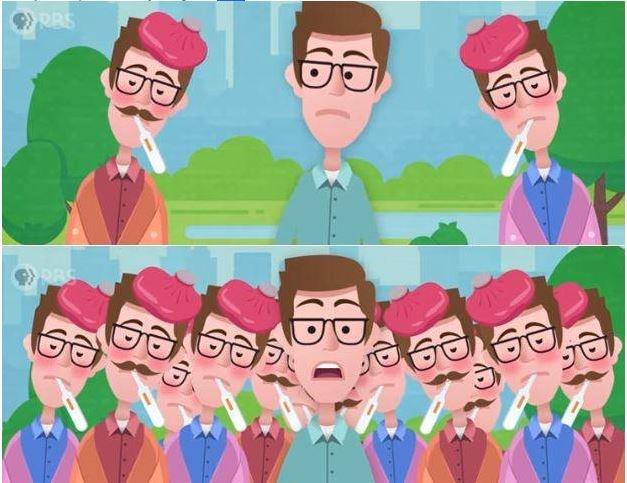Digital Studios pushes PBS headlong into a Web future.
“It’s Okay to Be Smart,” a YouTube series, has a quick beat and a witty host. It jumps through a slate of interesting, relevant-to-today topics and once you hit the on-screen “play” button, it’s hard to stop watching.
But entertainment is not the main purpose of the science-themed PBS Digital Studios program hosted by Dr. Joe Hanson. On March 17, as the first shockwaves of the COVID-19 pandemic began to register in North America, PBSDS ran a special episode of “It’s Okay to Be Smart,” called #FlattenTheCurve. It broke down and explained our unprecedented nationwide effort to slow the spread of the novel coronavirus.
By the time I caught up last week with head of PBS Digital Studios Brandon Arolfo, the #FlattenTheCurve episode had attracted 2.7 million views.
Arolfo sat down with us and shared not only PBSDS’s up-to-the-moment activities, but also how the studio, now in its seventh year, went from idea to the Internet. His answers have been edited for clarity and length.
Dan Macy: How did PBSDS come into being?
Brandon Arolfo: In 2012, PBS started experimenting with YouTube, which was coming into its own at that point. PBS had a few viral hits with what’s referred to as PBS Remixes. This success proved there were digital audiences ready to receive PBS content, and the organization began to allocate resources to what is now known as PBS Digital Studios. Today, virality is still great, but for PBS it’s about building audiences over time, and keeping them coming back week after week for more great content.
Today we have 20 active digital series that publish weekly or bi-weekly. Each week we have between 10 and 20 new episodes published … we have 25+ million subscribers and fans across YouTube and Facebook. … Our content is also available to member stations to use for local broadcast during interstitial breaks [short timeframes between full-length programs]
Macy: What is your most pressing challenge?
Arolfo: Like most PBS teams, it’s lack of resources. To keep up with ever-changing digital trends and audience behavior, we need more resources and money.
Macy: Do you have a target audience?
Arolfo: It depends on the programming and content goals, but overall we try and target the 18 to 40-year-old demographic.
Macy: Is YouTube your primary channel of distribution?
Arolfo: YouTube is our most popular platform and where our largest audience is found. But we’re also on Facebook Watch, PBS OTT [channel through which video and other content is delivered via the internet], PBS.org, IGTV [Instagram TV] and other platforms. …[W]e interact with YouTube and others at Google often. This includes representatives from YouTube’s educational vertical [software] that are dedicated to PBS, as well as others within the YouTube universe.
Macy: What message about PBS Digital Studios do you most want to get out there to the public at large?
Arolfo: PBS is developing and distributing great content and engaging with audiences differently than most other networks. We aren’t driven by the bottom dollar, or by traditional commercial goals — we’re here to listen to the American public and serve them with content that trust and love, with no commercial strings attached.
Macy: …. And, to people within PBS?
Arolfo: Through digital platforms, PBS can do more than just distribute great content for younger audiences. By their nature, digital platforms are engaging, and [we want to show] you can have a conversation with audiences that you can’t always have on broadcast.
Macy: Do you envision news and public affairs as part of your mission in the future?
Arolfo: Yes, by all means. We have long discussed creating news and public affairs content. We would love to partner with established PBS partners to create that type of content and build that kind of audience. There is great potential there.
Macy: Since the COVID-19 pandemic cropped up, after we began talking about PBSDS, it’s important to know if you are now responding directly to the coronavirus pandemic. Have you produced – or do you plan to produce – any specialized content about this global crisis?
Arolfo: Yes, the PBSDS team, our hosts and producers are developing content related to COVID-19. That’s part of the beauty of digital content, you can respond quickly. Several series have begun to publish special episodes, including Dr. Joe Hanson’s “It’s Okay to Be Smart.” Take note that its #FlattenTheCurve episode, published on March 17, has already been viewed more than 2.7 million times, just on YouTube.
Another program that combines braininess with fun is PBSDS’ Physics Girl, which has 1.52 million subscribers on YouTube. In a recent video, Physics Girl works through everything from the properties of surface tension and non-Newtonian fluids to the principle of center of gravity (see box) without breaking anything more than a solitary unfortunate egg. All of this happens inside a video lasting less than eight minutes. The only thing she doesn’t explain, it seems, is what you’ll do with the rest of your day stuck indoors. Fortunately, there is plenty more PBSDS material to watch, and it’s always being updated.
Physics Girl Those looking for escapism and a jolt of frenetic energy can call up a short video from March 20 that follows Physics Girl – stuck at home – as she rushes through her house conducting scientific “DIY” experiments. She has challenged herself to finish 20 of them in five minutes. She gets all 20 done and only goes over by 18 seconds. For the attention-span challenged, it’s a salve. She uses all of eight seconds and one egg to demonstrate the property of impulse. The egg gets thrown twice; its second trip across the room ends badly. She dispenses with the principle of center of gravity in a mere 11 seconds, a feat Archimedes probably never even attempted all those years ago.
|



